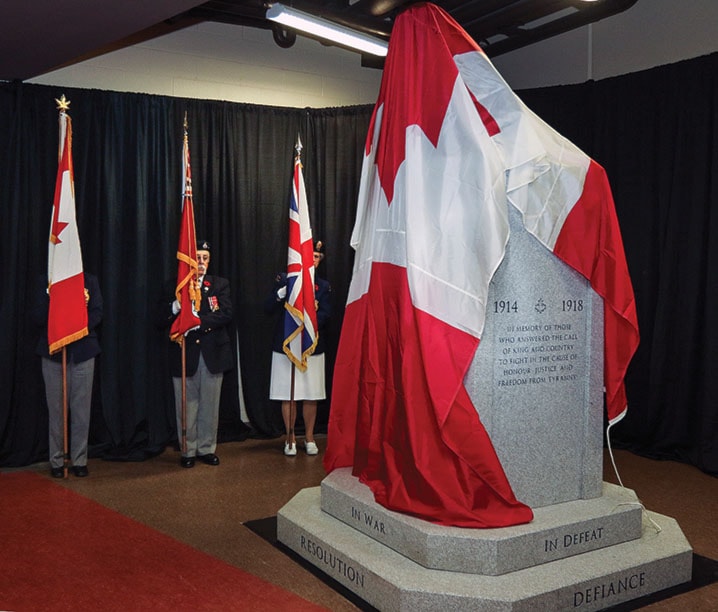A cenotaph and a restored First World War memorial stage curtain were unveiled here Thursday to honour Canadian soldiers’ sacrifices.
Speaking to our modern generation, for whom world wars are almost unimaginable, keynote speaker retired Maj.-Gen. Lewis MacKenzie reminded his audience how lucky Canadians are.
Two weeks before returning to Canada, after serving as commander of Sector Sarajevo in the former Yugoslavia, he saw a group of teenagers being given food by the Canadians killed or horribly mangled in front of his eyes by a mortar shell explosion.
On returning to Ottawa, the big news of the day was the GST and the Grey Cup weather forecast.
“What a God-given blessing we have to be able to sweat the small stuff,” said MacKenzie, who is one of Canada’s best-known soldiers and the first to receive two Meritorious Services Crosses for his leadership in a 36-year military career.
“It’s just unbelievable how much we take for granted.”
MacKenzie was joined by Alberta Lt.-Gov. Lois Mitchell and many other provincial and municipal dignitaries at the memorial event in Penhold Regional Multiplex. They were piped into the gymnasium along with a colour party.
Nobody was taking peace for granted in 1920, when the Penhold stage curtain was commissioned and painted with a view of an iconic image of the gilded statue of the Virgin Mary atop a basilica in Albert, France.
Damaged by shellfire and hanging precariously at an angle, the statue was seen by tens of thousands of Canadians marching to the front. Legend had it that when the statue fell the war would end.
The curtain hung for decades on the stage of the Women’s Institute Penhold Memorial Hall that was built in 1919 to remember all those who served in the Great War.
In modern times, the crowds who line the Highway of Heroes, those who have supported injured soldiers in sporting events, and initiatives to help soldiers cope with post-traumatic stress disorders through canine and equine therapy all show Canadians stepping up to help their soldiers.
“The drop curtain and the cenotaph is another example of local organizations coming together and creating something for their community.”
MacKenzie is among those backing a monument on a national scale at Cape Breton to remember the Canadian soldiers buried in 2,500 cemeteries around the world. Permission has not yet been granted for the 25-metre statue based on the famous Mother Canada monument that stands over the site of the Vimy battlefield in France.
Local historian Michael Dawe spoke of the impact the First World War had on Penhold and area, then a thriving farming community.
At the Battle of the Somme alone, 47 men from the Penhold area were killed. Three times as many were wounded.
Dozens of others died at Vimy and Passchendaele. In all, nearly 120 Central Albertans lost their lives in the war.
When they returned home, the Spanish flu epidemic was at its peak and the local economy was in tatters. Unemployment in Penhold was at 25 per cent after the war.
Despite this, the Women’s Institute managed to scrape together enough donations and volunteer help to build the Memorial Hall that still stands.
The curtain hung in the hall until the 1960s when it was taken and forgotten for 40 years when it was uncovered during hall renovations. Local man Stewart Ford made sure the curtain was saved.
Gifted to the Canadian War Museum by the town, the curtain underwent a meticulous four-month restoration.
Mark O’Neil, president and CEO of the Canadian War Museum and the Canadian Museum of History, said before the unveiling the curtain is believed to be the only surviving curtain of its kind in North America.
It will hang at the multiplex for six months before being returned to the museum in Ottawa.
